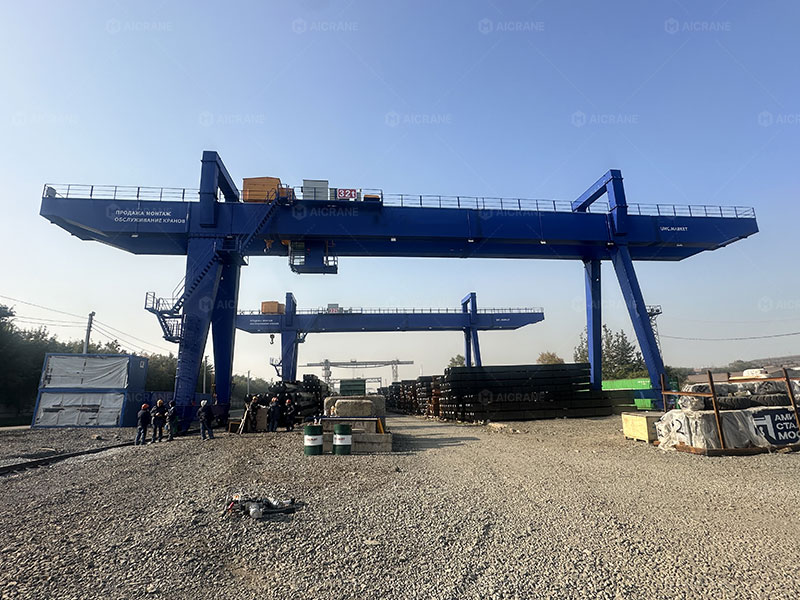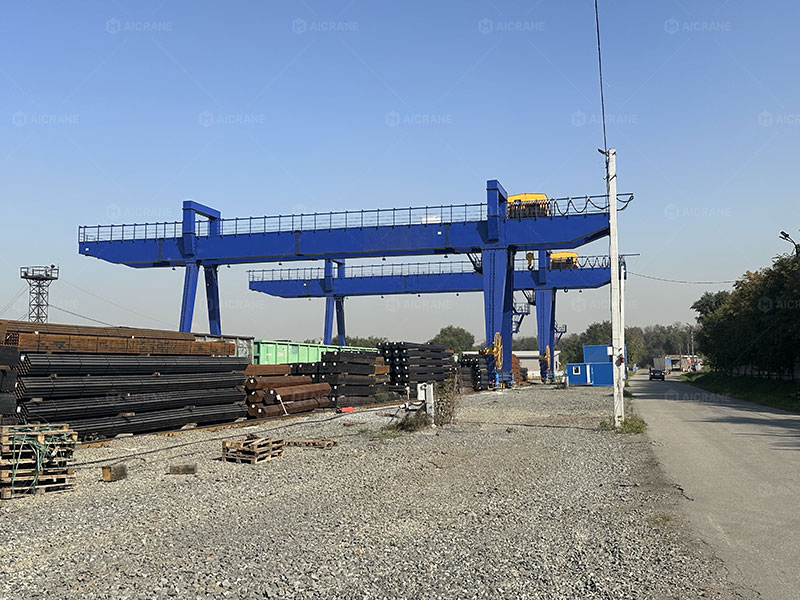In industrial operations, gantry cranes play an essential role in lifting and transporting heavy materials safely and efficiently. Among them, the 30-ton gantry crane is widely used in construction sites, shipyards, factories, and logistics centers for handling steel, concrete components, machinery, and containers. However, despite its robust design and high load-bearing capability, the 30-ton gantry crane is not immune to damage or failure – particularly when subjected to overloading. Overloading, whether intentional or accidental, is one of the most common causes of premature wear, mechanical failure, and safety incidents. Understanding how overloading affects crane safety and service life is crucial for operators, maintenance teams, and management alike.

What Is Overloading in a 30 Ton Gantry Crane?
Overloading occurs when the crane lifts a load that exceeds its rated capacity – 30 tons in this case. The rated capacity is not just an arbitrary figure; it is calculated based on detailed structural analysis, material strength, and safety factors defined by engineering standards such as FEM, ISO, and CMAA.
Overloading can happen in several ways:
-
Direct overloading: lifting a load heavier than 30 tons.
-
Dynamic overloading: when a load is lifted too quickly or swung suddenly, creating dynamic forces that exceed the rated limit.
-
Uneven load distribution: when the weight is not evenly distributed across the crane’s span, causing one side or one beam to bear excessive stress.
-
Hidden overloads: often caused by inaccurate weight estimation or load slippage during lifting.
Even a single episode of overloading can cause hidden damage that shortens the 30 ton gantry crane service life, while repeated overloading can lead to catastrophic failure.
Structural Impacts of Overloading
The most immediate effect of overloading on a gantry crane is the strain it places on its structural components.
Deformation of Main Girders
The main girders of a 30-ton gantry crane are designed to withstand specific bending moments. When overloaded, these girders may bend permanently, even if the deformation is not immediately visible. Over time, micro-cracks can develop at the stress points, reducing structural integrity and increasing the risk of collapse.
Fatigue Cracks in Welds and Joints
Welded joints, which are common in the crane frame, are particularly sensitive to overload-induced stress. Each overload cycle accelerates fatigue, leading to crack propagation at weld seams. Once cracks form, they can grow rapidly under cyclic loading, eventually leading to structural failure if not detected in time.
Increased Stress on End Beams and Wheel Assemblies
Overloading causes excessive pressure on the end beams and wheel assemblies that support the crane on its tracks. This can result in misalignment, excessive wheel wear, or even track deformation, all of which affect the crane’s ability to travel safely and smoothly.

Effects on Mechanical Components
Overloading does not just affect the structure – it also takes a toll on the crane’s mechanical systems, including the hoisting mechanism, trolley, and travel drive.
Hoisting Mechanism Damage
The hoist is the heart of the gantry crane, comprising the motor, gearbox, drum, and wire rope or chain. When lifting beyond capacity, the gearbox experiences higher torque, causing gear tooth wear or breakage. The wire rope may stretch beyond its elastic limit, lose tensile strength, or even snap, posing serious safety risks to personnel and equipment below.
Brake System Overstress
The brake system, designed to stop and hold loads within rated limits, can fail under excessive load. Brake pads wear faster, and braking distance increases, reducing control during lifting and lowering operations. In severe cases, brake failure can cause dropped loads or uncontrolled movement.
Motor Overheating and Burnout
The electric motor driving the hoist and trolley experiences increased current draw under overload. Continuous overloading causes overheating, insulation breakdown, and ultimately motor burnout. This not only interrupts operations but also results in costly repairs and downtime.
Electrical and Control System Stress
Modern 30-ton double girder gantry cranes often use frequency inverter control systems and overload protection relays. When an overload occurs, these systems detect abnormal current or torque and may trip to prevent further damage. However, repeated overload events can degrade electronic components, shorten their lifespan, and reduce reliability.
Furthermore, if the overload protection system is bypassed or malfunctioning – a common problem in poorly maintained cranes – the entire control system is exposed to excessive electrical and mechanical stress, making the crane unsafe for operation.
Safety Hazards Caused by Overloading
Overloading does not just damage the crane – it endangers lives and property. The following are the most serious safety risks:
-
Load Drop: A broken rope, failed brake, or collapsed structure can cause the load to fall, leading to fatalities or severe damage.
-
Crane Collapse: Continuous overloading may lead to frame instability, especially during lifting at the maximum radius or in windy conditions.
-
Track Derailment: Excessive wheel pressure may cause the rail gantry crane to derail, particularly on uneven tracks.
-
Swing and Collision: Overloaded lifts are harder to control, increasing the risk of the load swinging into personnel, vehicles, or nearby structures.
According to safety studies, overloading is one of the top three causes of major gantry crane accidents worldwide, alongside poor maintenance and operator error.
Long-Term Effects on Service Life
Even if a crane survives an overload incident without immediate failure, its service life is significantly shortened. Structural fatigue, material degradation, and mechanical wear accumulate over time.
A 30-ton gantry crane typically has a design life of 20 years or more under normal working conditions. However, frequent overloading can reduce this lifespan by half or more. The crane may require major component replacements (motors, wire ropes, brakes) far earlier than expected, and safety inspections will reveal increasing deformation and cracks with each overload cycle.
Preventing Overloading: Best Practices
To maintain safety and extend service life, it is essential to prevent overloading through both technology and operational management.
Use Load Monitoring Devices
Install load cells, overload limiters, or smart weighing systems that provide real-time load data. These devices can automatically cut off hoisting power when the load exceeds 100% of the rated capacity.
Operator Training
Operators should be trained not only to read load charts and understand weight distribution but also to recognize signs of overload, such as abnormal noises, slow hoisting, or excessive deflection of girders.
Regular Maintenance and Inspection
Routine inspection of structural welds, wire ropes, hoist drums, and brakes helps detect overload damage early. Any sign of permanent deformation or cracking should prompt immediate repair.
Avoid Dynamic Overloading
Operators should lift smoothly without sudden starts or stops, and avoid side pulling or swinging loads. Proper use of anti-sway controls and soft-start drives can reduce dynamic stresses.
Strict Compliance with Load Limits
Management should enforce strict operational discipline – no exceptions for “temporary” or “minor” overloads. A culture of safety is as important as mechanical protection systems.
Conclusion
Overloading is one of the most preventable yet most destructive factors affecting 30-ton gantry crane safety and longevity. It places excessive stress on structural, mechanical, and electrical components, accelerates wear, and introduces severe safety hazards. Even a single overload event can cause hidden damage that compromises future performance.
By enforcing load limits, using advanced overload protection systems, and training operators properly, businesses can ensure their 30-ton gantry cranes operate safely and reliably throughout their design life. Investing in prevention is far more cost-effective than dealing with the consequences of a catastrophic overload failure.